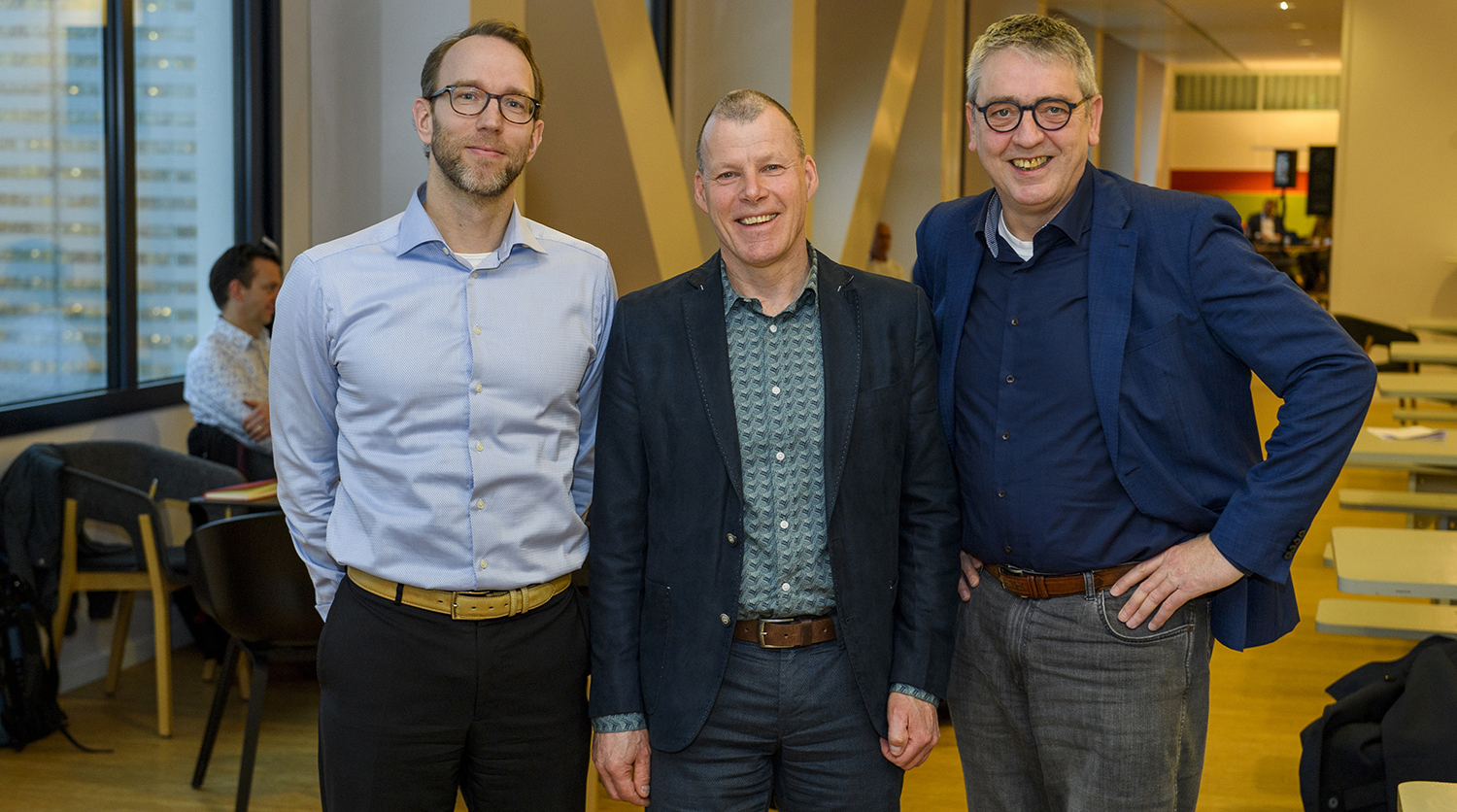Electricity
In 2019, flexibility and congestion management were established as important building blocks for implementing the Climate Agreement. The rapid emergence of renewable energy sources has led to bottlenecks in the electricity grids at various places within the Netherlands.
Future-proof grids
In 2019, much attention was paid in the press and in the House of Representatives to a suddenly emerging shortage of transmission and distribution capacity, potentially endangering our success in achieving the climate objectives. We were already aware of this issue for some time. The grid managers in the Netherlands are working together on solutions to this issue, with a focus on speeding up grid construction. Particular consideration is also given to possibilities for matching electricity supply and demand more smartly as well as for further testing the technical limits , to ensure that bottlenecks cannot arise or will only develop later. Flexibility is key with this regard. An example is the GOPACS platform referred to previously. In GOPACS, we also learn how to shape the interaction with TenneT, other grid managers and market parties effectively, so as to safeguard a reliable electricity grid going forward.
We see an increase in both private and business customers actively seeking local cooperation with one another as a means of putting their sustainable ambitions into practice. We encourage this trend as a grid manager, since it enables them to help realise a more efficient use of the electricity grid. Increasing automation, changing regulations and adjustment of the netting arrangement for owners of solar panels are creating new opportunities for accelerating this development.
Regional Energy Strategy (RES)
The commitments in the Climate Agreement relating to electricity and the built environment require each region to develop a regional energy strategy, or RES. During 2019, Stedin was actively represented in nine RES regions where we are the largest grid manager as well as in a further five regions where other grid managers are responsible for the major part of the electricity and gas grids. Together with the public authorities, businesses, residents and partners, we are exploring the possibilities for the regional generation of sustainable energy, for instance; mainly from wind and solar parks. With regionally oriented teams, each RES region has its own area director and account managers provided by Stedin who are responsible for the results in their area. To facilitate this process, we created opportunity maps for each RES region. The opportunity maps show where there is still sufficient capacity for solar and wind farms on the current electricity grid in the short and longer term. These opportunity maps have already been successfully used in several RES regions. The proactive approach will be continued in 2020 with the aim of creating an RES 1.0 (a draft RES) for each region.
Transition together
Province of Zeeland records a first: Draft RES passes national ‘impact test’
Zeeland was the first province in the Netherlands to develop a draft Regional Energy Strategy (RES). In August 2019, the RES was tested for content and process by experts from various national organisations as well as public authorities. Through this so-called 'impact test', in which Enduris was closely involved, the energy strategy of Zeeland was tested against the national framework.
Zeeland was given the opportunity to explain the draft RES in terms of content as well as process. Among others, representatives from the RES National Programme, the Ministry of the Interior as well as and the Ministry of Economic Affairs and Climate Policy took part in focus groups. The province was complimented on the speed and meticulousness of the process, which are unmatched by any other region. The national representatives were impressed by the quality of the work that they were asked to assess. There was also much praise for the process: the early involvement of the grid manager and the many stakeholders who were able to make a contribution through the sector platforms.
Making network information available
Digitalisation and data management
Data are crucial to ensure that our grids remain manageable during the energy transition. In 2019, we worked hard to develop several products that help us make data more quickly and easily available. Two products that stand out are Data Warehouse and Datalake 2.0. Datalake 2.0 gathers raw data from our assets and systems. The system has been delivered but is not yet operational. It awaits the input of data, which is scheduled to take place in early 2020. Data Warehouse puts the data in context and makes them 'readable', so they are usable by analysts and others in the organisation. We will complete Data Warehouse in 2020.
Next-generation assets
We also welcomed the next generation of smart assets, including the Smart Grid Terminals. Assets such as the Smart Grid Terminal provide comprehensive insight, helping to ensure that the electricity grid remains efficient and reliable in the future. Possibilities are also created for integrating the sustainable and decentralised generation of electricity. They represent a significant expansion of our 'secondary network', i.e. the IT network that 'reads' our primary network. These secondary assets generate data that we need to access safely in order to make them available for use. As a result, the growth of the secondary network has increasing strategic and operational importance.
In 2019, we successfully read out 2,000 Smart Grid Terminals. We plan to transfer the data from the OT domain to the IT domain in the first quarter of 2020. This process will enable us to make broad use of the data from the networks as well as to analyse the data.
Availability of smart meter data (in per cent)
Stedin uses two telecommunication networks to read out smart meter data. Based on the coverage maps of the GPRS and CDMA networks, Stedin decides which communication technology to use at a particular location for the smart meter. A significant number of smart meters were nonetheless unsuccessful in establishing a link with the transmitter, as a result of which data were not received – or not always received – from the meter concerned. In early 2019, a prediction model was developed that determines which communication technology has the greatest likelihood of success at a particular location. This model increases the probability of the right meter being installed the first time. In addition to a better score, this process also leads to several thousands of euros in cost savings. Adjustments in the read-out process have also led to significant improvements.
Using available network information for the energy transition
The available data provide us with insight into the grids, which helps us to manage congestion better. In 2018, we started quantifying all 17,000 low-voltage grids. Quantifying grids provides an up-to-date view of the grids on an automated basis. This model enables us to save hundreds of hours of drawing work. In 2019, we successfully extended quantifying grids to our medium-voltage grids, allowing us to map our entire grid. We have now mapped 90% of the low-voltage grid.
Digitalising the grids and structuring data management are also high on the list of priorities. In practice, this process proves to be complex mainly in relation to IT. We aim to make considerable advances with this regard in 2020. For 2020, this data-driven ambition is set out in the 'System Operator' initiative.
Transition together
LEF in Hoog Dalem district of Gorinchem
In 2019, we launched the LEF concept in collaboration with our partners ABB, i.LECO and Energy21. LEF stands for Local, Energy and Flexible. We are testing this concept for local electricity production and consumption in the residential district of Hoog Dalem in Gorinchem. The 15 residents taking part in the pilot can see how much electricity they are producing and consuming on their block chain-enabled application. They also see how much energy they have traded with neighbours, which they are therefore justified in claiming to be locally generated sustainable energy. A second pilot on the LEF Greenparc Bleiswijk business park will go live in 2020.
Data analytics & quantifying grids
Significant advances were also made to increase knowledge and make new systems usable for the organisation; for instance, by using data analytics. Based on this approach, we can make smart investment choices. Part of the products are now available for use. New grid quantification tools, for example, will allow us to prepare future grid scenarios within a few hours and will shortly provide information on the quality of a specific grid. In the past, this process often took up to several weeks and the result was less accurate. This way, we can quickly decide whether cables need to be shortened, or whether a transformer needs to be added or configured differently. These future scenarios help us to make effective investments. We also provide opportunity maps for the RES and project developers, among others, showing where there is scope and capacity for sustainable initiatives such as solar farms. This approach also helps us to prevent congestion.
Data management
Every day, we use existing data and store new data: when working on the grid, serving customers, working with contractors and preparing reports. Incorrect or wrongly entered data cause us problems. We are working to improve data management so we can base our eventual decisions on the right data and help our customers effectively the first time. In 2019, we focused on making data locatable, accessible and reliable. We defined a clear standard for data processes and toolings were made available for this purpose.
Set of agreements on data-sharing
The energy transition will also require us to share more data with more market parties than is presently the case. New EU
legislation (Clean Energy Package), the government's vision for a data economy as well as the vision of the Netherlands Authority for Consumers and Markets (ACM) on governance in relation to data-sharing in the energy sector have led to an initiative of the Dutch grid managers. In 2019, they were among the first in Europe to develop a 'set of agreements on data-sharing'. Intensive contact with relevant market parties, the Ministry of Economic Affairs and Climate Policy, the ACM as well as the Dutch Data Protection Authority resulted in agreement being reached on this matter with all the parties at the end of 2019. The set of agreements is in line with EU data legislation that is expected to be introduced in the coming years. In this endeavour, the Netherlands is leading the way. The agreements will be implemented in 2020 and 2021.

Natural Gas-free Project Manager Leendert Odijk (on the left) and Overvecht-Noord Natural Gas-free Programme Manager Mark Elbers (on the right) are transitioning together with Robert Schenkel, Key Account Manager at Stedin (centre). 'We are designing the future energy infrastructure of the Overvecht-Noord district in Utrecht without the use of natural gas. Along with residents and other parties involved, we will implement an affordable and sustainable plan, in which all interests have been properly weighed.'
